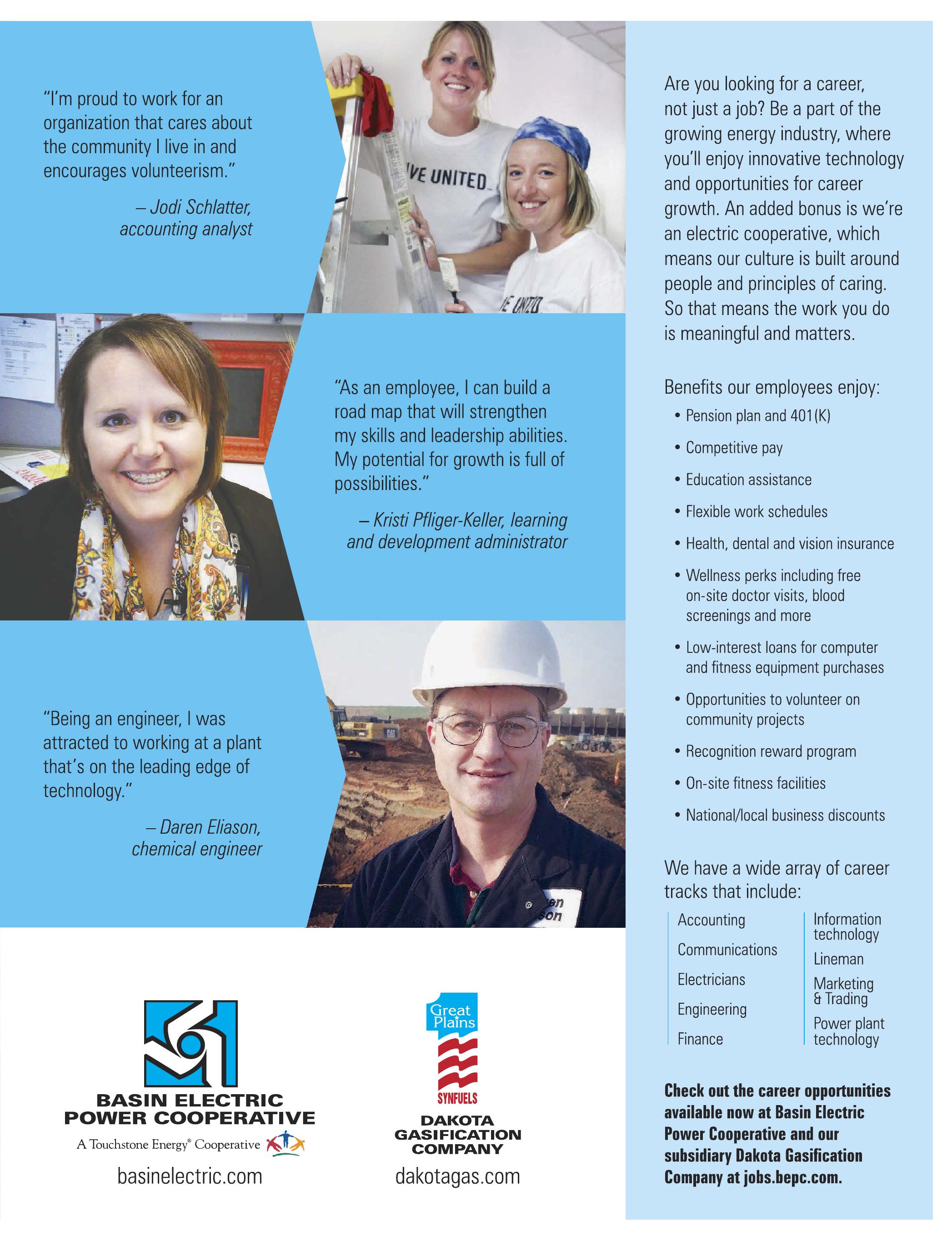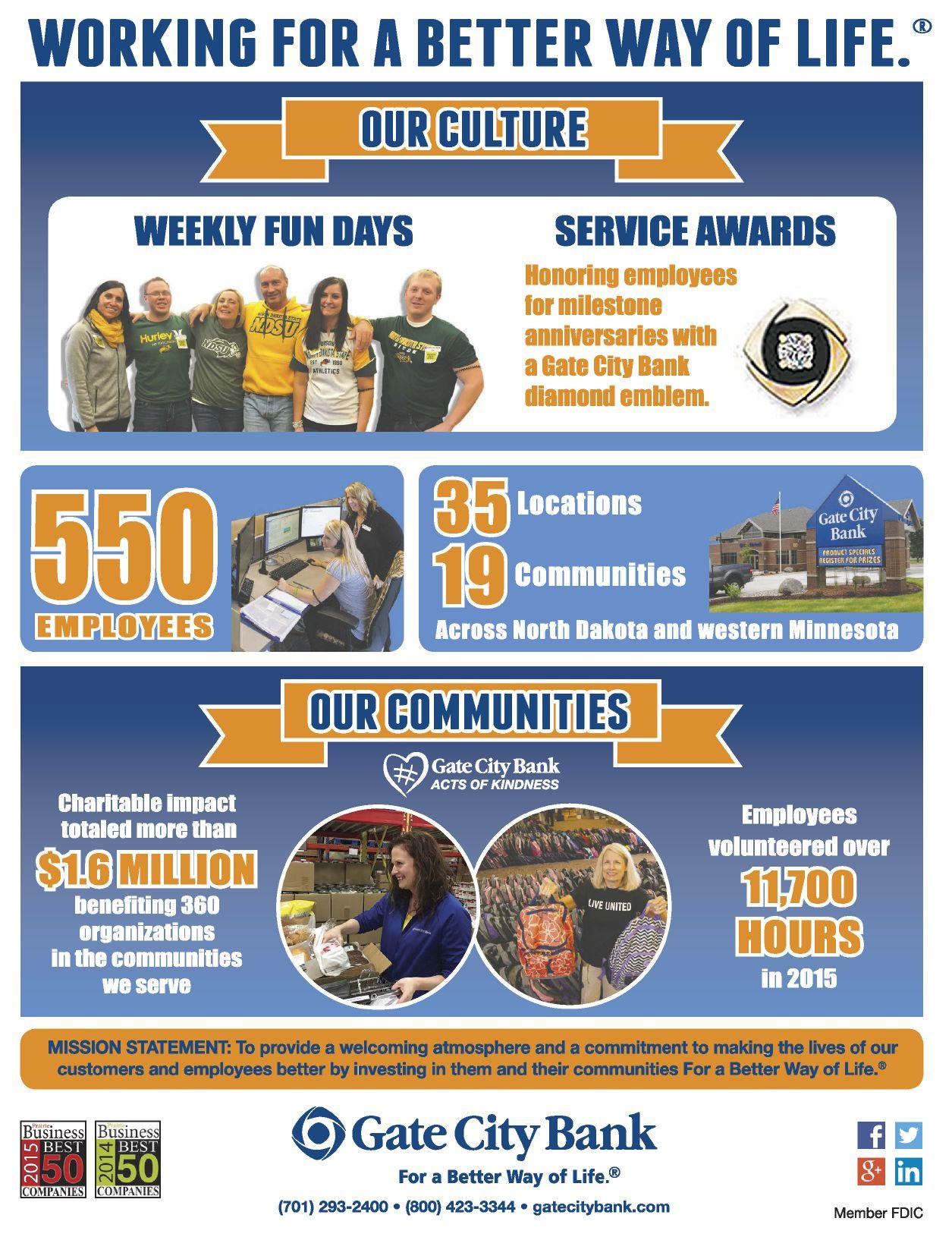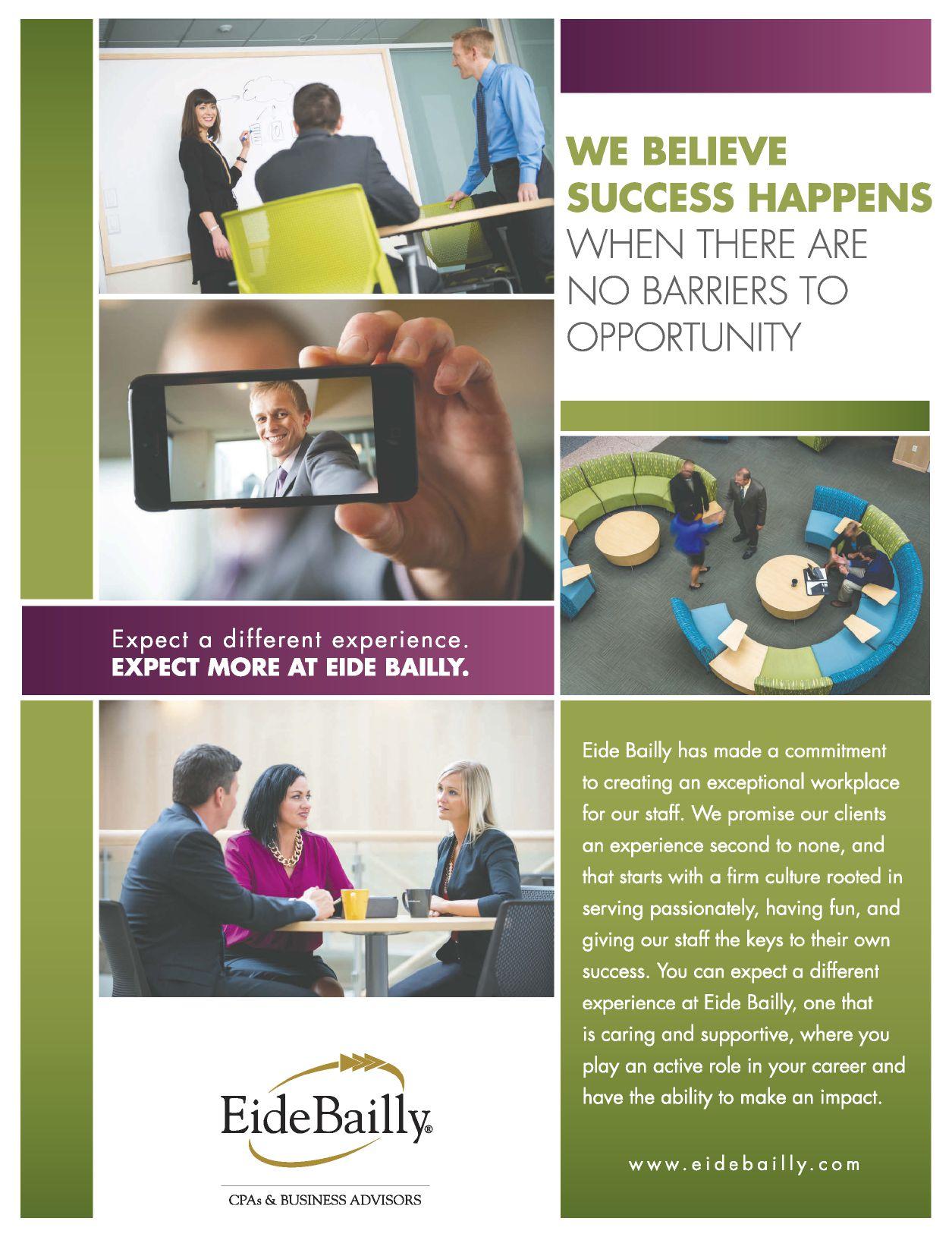
9 minute read
Jason Sutheimer
President, Central Dakota Human Resource Association
Bismarck, N.D.
How can businesses effectively recruit and retain employees?
The key to effectively recruiting and retaining employees is to know your business, industry, market segments and work requirements. These factors will change the programs required to effectively recruit and retain employees.
Organizations need to start by researching these factors to know and understand what programs are being utilized to attract workers to similar jobs and markets. This will require organizations to conduct total compensation surveys, utilize labor market surveys (available at local Job Service offices), ensure they have an effective performance review process and conduct stay interviews with their employees. A stay interview will outline why an employee works for your organization, why they continue to work for your organization, what would cause them to leave your organization, what parts of their job they like and dislike, what they like or dislike about the benefits your organization offers, etc.
Once an organization knows this information, it can analyze what motivates the most productive employees. This information should then be used to develop more effective recruiting and retention programs to recruit and retain more productive employees.
Are certain benefits and programs, such as employee stock ownership, often factors in employees’ decisions to work for one company versus another?
An organization’s benefits and programs are a key factor an applicant uses when making a decision in regard to applying for a position with an organization. The important thing to remember is every employee is different. Things such as age, gender, family status, culture, personality, career tenure and others can all affect what an employee is looking for in a benefits package. Despite these differences, an organization must ensure their benefits program does not discriminate on any of these factors. Therefore, an organization must research which benefits are vital to recruiting and retaining a highly productive workforce.
How can companies become more inclusive and diverse?
Diverse teams have been proven to outperform like teams in various studies. Therefore, it is imperative for organizations to value and promote inclusion and diversity throughout their organization to maximize their profit and potential. There are many things an organization can do to increase the diversity of their workforce. Things such as posting positions with diverse colleges and professional associations, advertising in publications with large diverse readership and recruiting outside of their normal venues are all very easy ways to increase the exposure the organization has with diverse applicants.
What are some of the most effective measures employers can take to enhance workplace culture?
The culture of an organization starts with the organization’s executive management. Therefore, the top executive officer must outline the culture they want the organization to portray and hold all employees — regardless of position, performance, organization value, etc. — accountable for the culture.
What are some of the most interesting or unique culture initiatives you have seen implemented?
One of the most interesting initiatives is work-life integration. Worklife balance initiatives have received a lot of attention over the past few years as employees have desired having time for both work and family. However, the concept of work-life integration takes work-life balance one step further by integrating an individual’s life into their jobs. This is done through a variety of means such as allowing the employee’s family members to participate in wellness program activities, paying for family members’ travel and additional paid travel days when the employee attends conferences and training sessions out of state, allowing paid time for volunteering and charity activities and allowing employees to work whenever and wherever they prefer.











More than rocks!
Who We Are
Fisher Industries is a �ami�y o� �usinesses that serves a�� as� �ects o� the aggregate industry� Whether its manu�acturing aggregate �rocessing equi�ment, mining and de�ivering ag� gregate �roducts, or the �na� ro��er �ass across �resh�y �aid as�ha�t, �e stand ready to tack�e the toughest �o�s� But �e are so much more than �ust rocks� We are a uni�ed team, �orking together to cement our ��ace in the industry� From accountants to �e�ders, �e em��oy over 1,000 �ro�essiona�s during our �eak seasons�

What We Offer
In addition to �01�k� ��ans, com�any s�onsored term �i�e in� surance, and �ro�t sharing, Fisher Industries has esta��ished a variety o� �ene�t �rograms to enhance the �ives o� our em� ��oyees and their �ami�ies� Em��oyees have the o��ortunity to customi�e their �ene�ts to meet their individua� needs� We a�so re�ard years o� service �ith signi�cant insurance �remium discounts�
Hard Work And Fun Too

�t Fisher Industries �e �ive u� to our motto: �We �ike the ���GH �o�s��, �ut �e a�so consider our em��oyees our most va�ua��e asset� �hat is �hy throughout the year �e s�onsor a variety o� events that �oth sho� our a��reciation �or �o�s �e�� done, and a�so give em��oyees a chance to un�ind and have �un� �hese events inc�ude: ho�iday �arties, em��oyee �uncheons, annua� go�� scram��es, com�any �icnics, mi�e� stone �arties and more�
Fisher Facts
Founded
By Gene Fisher 1952
Headquarters 3020 Energy Drive Dickinson, ND 58601
�What I �ove a�out �orking �or Fisher Industries is that even though they are s�read through� out many states, it sti�� �ee�s �ike a �ami�y� �hey genuine�y care a�out their em��oyees��
���ce �ocations in �ri�ona, �ontana, Nevada, Ne� �e�ico, North Dakota, South Dakota, and Wyoming
Fisher Industries is:
Fisher Sand � Grave� �om�any
Genera� Stee� � Su���y �om�any
Fisher Grading � E�cavation
Fisher �eady �i�
�ri�ona Dri��ing � B�asting
Fisher Sand � Grave� � Ne� �e�ico, Inc�
South�est �s�ha�t
South�est �s�ha�t �aving
Rikka Brandon Founder, RikkaBrandon.com Moorhead, Minn.

ow can businesses effectively recruit and retain employees?
There are a million ways to recruit great people. It really depends on your market, the type of position you are hiring for and the realities of the position. But, in the interest of brevity, here are my ABCs of recruiting great people.
A is for Adaptable
As a small business, you have much more freedom to accommodate the wants, needs and desires of your ideal hires than a large company does. Your ability to be flexible can be your greatest selling point.
B is for Brave
If you simply post your job description online and hope someone good applies, you will almost always be disappointed. It’s much easier to connect with experienced, local talent than you think. I even created a free training on it. You can access it at www.rikkabrandon.com/network.
C is for Curious
Ever been stuck talking to someone who only wanted to talk about themselves? It’s awful, right? By being curious, you not only learn more about potential hires, but they like you for it. Win-win.
Want to learn what D is? You can check out the video I made on the ABC’s of recruiting at www.RikkaBrandon.com/abc.
Want to retain great people? It’s not as simple as the ABCs, but it is as simple as ECR.
◆ Engage them. Get them excited about what you are doing. The more engaged and invested your employees are, the less likely they are to leave.
◆ Challenge them. The best employees want to be given the opportunity to stretch and grow. Give them opportunities to take on more, just make sure you’re setting them up for success.
◆ Reward them. Once they succeed, reward them. Money is always good, but time off or public praise can be nearly as effective.
re certain benefits and programs, such as employee stock ownership, often factors in employees’ decisions to work for one company versus another?
Yes, for most professional-level employees, they are considering the total value of their package when assessing an opportunity. According to a study by GlassDoor in 2014, the five biggest factors job seekers take into consideration before accepting a job offer are salary and compensation, career growth opportunities, work-life balance, location/commute and company culture and values.
ow can companies become more inclusive and diverse?
Step 1: Decide to.
Step 2: Watch the Ted talk “What does my headscarf mean to you” by Yassmin Abdel-Magied. This 14-minute talk should open eyes and hearts in your organization.
Step 3: Follow her advice. Seek out people who don’t fit your “usual hire” and start being amazed.
hat are some of the most effective measures employers can take to enhance workplace culture?
Listen to your staff. It doesn’t always have to be a big corporate initiative. Sometimes it can be more one-on-one time with their manager or a more in-depth career progression plan; sometimes it’s as simple as chair massages on Wednesday.
Pay attention. If you pay attention, you will know when you are starting to lose someone or the team. Then address it. Sometimes simply asking the question, “What’s going on?” can be your most effective retention tool. Get rid of toxic people. These difficult employees are bringing everyone down, and as a leader, you need to address it. Does the thought of addressing their behavior stress you out? No problem. I created a free training to help. You can check it out at www.RikkaBrandon.com/toxic.
H A H W W hat are some of the most interesting or unique culture initiatives you have seen implemented?
The Atlassian CEO talked about putting a simple iPad on a stand with three choices for employees leaving work — the first was a smiley face, the second was a neutral face and the third one was a middle finger. Simple, but wildly effective, for taking a daily pulse of your team.
I think the Results — Only Work Environment initiative is about the coolest system I’ve ever seen to give employees the freedom of entrepreneurs. You can learn more at www.gorowe.com.













Tamara Anderson
Vice President, Dale Carnegie Business Group of North Dakota Fargo, N.D.

How can businesses effectively recruit and retain employees?
There are two ways to source talent. One is to develop it from within the organization. The other is to recruit and select talent from outside the organization. One important recruiting asset we often overlook is our own employees. These individuals have the qualities and characteristics you’re looking for. They know the organization, its values and its culture. The most direct way they can impact is through candidate referrals. One common mistake we see among organizations is that once they’ve recruited the employee, they assume the job is done. We need to be constantly re-recruiting our employees in order to keep them engaged and win their mind, heart, body and soul.
There are three key factors that drive employee engagement and retention, according to employee engagement research conducted by Dale Carnegie Training: satisfaction with their immediate manager, pride in the organization and belief in senior leadership. The most critical on that list is a manager’s ability to build strong relationships with employees, build strong team interactions and lead in a person-centered way that creates an engaging environment where employees can perform at their best.
A H re certain benefits and programs, such as employee stock ownership, often factors in employees’ decisions to work for one company versus another? ow can companies become more inclusive and diverse?
More and more, employees are looking for the right fit. While it’s important for organizations to have competitive benefit packages that include health care, vacation time, pay raise, performance bonus and 401k match, it’s equally important that prospective employees connect with the employer brand.
By 2020, 46 percent of the workforce will be made up of millennials. By 2025, they’ll make up 75 percent of the workforce. If organizations don’t understand and start including and engaging millennials now, we’ll have a major engagement crisis on our hands in just a few short years. And that’s not only about figuring out what makes millennials do their best work, but also how to deal with the friction that exists between millennials and older generations.
What are some of the most effective measures employers can take to enhance workplace culture?
• Millennials want to be able to do the work they were hired to do with a certain degree of autonomy. Help should be available and ready when needed. For smaller organizations, peer-to-peer mentoring can help millennials feel supported not micromanaged. In larger organizations, regular training and new opportunities can help maintain that sense of opportunity and challenge that millennials crave.
• When executives clearly define company goals and every employee bases his or her goals off of these, employees will feel part of something bigger than themselves, and engagement increases. One way to accomplish this may simply be to check in with employees formally (company retreats or periodic reviews) or informally (stop by an employee’s desk once a week or as time allows.
• Realize that what motivates millennials may not motivate other generations. Employees of all ages should be seen as people as well as producers. Not only will they feel valued and want to do their best, but you’ll be able to find out what matters to them, no matter what industry, size of company or age group you’re managing.
What are some of the most interesting or unique culture initiatives you have seen implemented?
• Game rooms — what appeals to techies? Games. Game rooms with traditional games like foosball and air hockey but also arcade games. Employers want their employees to have fun, which raises commitment and creativity levels, and they bring people together who might not normally interact on a daily basis.
• Collaborative work spaces — we work with companies who have a workspace designed a bit like your own home. Employee desks are arranged in pods where the walls between are low enough that they can see each other. The space includes a kitchen area with food options and seating. There are chairs and couches around a small fireplace. There are small side conference rooms when privacy is needed for a conference call or meeting. But, all in all, the space feels much more like one big family.
• Culture clubs — These are emerging in organizations that are really committed to make culture a priority. Culture clubs focus on building a stronger culture throughout their organization by championing efforts to improve the overall organization.

















